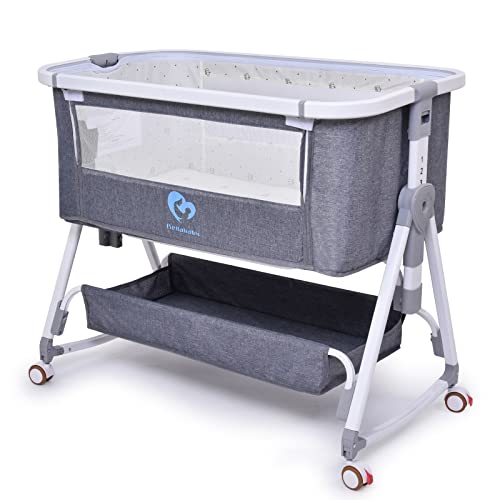What Experts In The Field Would Like You To Know
The Ultimate Guide to Bedside Cots for New Parents
As new parents embark on the exhilarating and sometimes frustrating journey of raising a kid, among the critical choices they deal with is where their baby will sleep. Cots 4 Tots that has gained popularity recently is the bedside cot. Providing benefit, security, and ease of access, these cots have actually become a favored choice for lots of parents. This short article looks into the benefits, functions, and factors to consider when selecting a bedside cot for new parents.
What is a Bedside Cot?
A bedside cot is created to attach securely to the side of the parent's bed, permitting easy access to the baby while offering them with their own sleeping space. These cots generally include adjustable heights, enabling them to line up with the height of the adult bed, along with safety functions to guarantee that the baby remains safe throughout the night.
Advantages of Using a Bedside Cot
- Ease of Access: New parents can quickly pick up or soothe their baby throughout nighttime feedings without requiring to rise.
- Reduced Risk of SIDS: Being able to keep track of the baby closely while they sleep can alleviate some concerns surrounding Sudden Infant Death Syndrome (SIDS).
- Promotes Bonding: The proximity to the baby permits more minutes of bonding, making it much easier for parents to respond to their child's needs.
- Co-sleeping Safety: Bedside cots permit the benefits of co-sleeping while keeping a safe sleeping environment for the infant.
- Space-Saving: These cots can fit snugly next to adult beds, making them a convenient option for smaller sized spaces.
Key Features to Consider
When picking a bedside cot, it is necessary to evaluate different features to guarantee that it meets your requirements and those of your baby. Below is a valuable table outlining critical functions to think about:
Feature
Description
Height Adjustability
Ability to adjust the cot to align with moms and dad bed height.
Protect Attachment
Mechanism to attach the cot securely to the adult bed.
Security Standards
Compliance with security policies and certifications.
Storage Space
Under-cot storage to organize baby basics.
Portability
Light-weight and easy to carry for travel purposes.
Bed mattress Quality
Non-toxic and breathable mattress for baby's convenience.
Relieve of Setup
Uncomplicated assembly and disassembly process.
Kinds Of Bedside Cots
Picking the best type of bedside cot can significantly impact its usability and functionality for new parents. Here are some common types:
- Traditional Bedside Cots: These are standard cots installed on wheels or a steady base that can be securely connected to the moms and dad's bed.
- Co-sleepers: Cots developed specifically for co-sleeping permit easy access and generally have detachable sides.
- Convertible Cots: These versatile cots can shift into a regular crib or young child bed as your kid grows.
- Portable Cots: Lightweight and collapsible, they are best for travel while still enabling close contact with the baby.
Selecting the Right Bedside Cot
With numerous choices readily available in the market, picking the ideal bedside cot can seem challenging. New parents must consider the following aspects:
Space Requirements: Measure the readily available space next to the bed to ensure the cot will fit without taking control of the room.
Budget: Bedside cots differ in costs. Figure out a spending plan and choose a cot that fits within your financial constraints, remembering that quality and security must not be compromised.
Material & & Design: Consider the products used, ensuring they are non-toxic and safe for babies. The design should likewise complement the home design.
Ease of Cleaning: Babies can be messy, so choose cots that have removable and washable materials or easy-to-clean surface areas.
User Reviews: Reading evaluations from other parents can offer important insights into the efficiency and safety of the cot.
Frequently Asked Questions (FAQs)
1. What is the suggested age for using a bedside cot?
The majority of bedside cots are ideal for infants from birth up to around 6 months, but this differs depending upon the particular model and design. Always refer to the manufacturer's guidelines.
2. Are bedside cots safe for newborns?
Yes, as long as the cot meets safety standards, is properly connected to the parent's bed, and is utilized according to the maker's guidelines.
3. Can I use a routine crib as a bedside cot?
Regular cribs are typically not created for bedside use, as they do not connect securely to beds. It's finest to use a cot specifically designed for this function.
4. How do I ensure the bedside cot does stagnate throughout use?
Always examine that the attachment mechanism is safely attached to the bed and consider using anti-slip pads for included stability.
5. How do I pick the right bed mattress for a bedside cot?
Search for a firm, breathable mattress created for infants that satisfies security requirements and fits comfortably within the cot without gaps.
Bedside cots provide a useful option for new parents, providing benefit, safety, and the ability to bond closely with their newborns. With numerous styles and functions available, parents should carefully examine their individual needs and choices to make an educated option. Ultimately, selecting a high-quality bedside cot can enhance the early parenting experience, guaranteeing both the baby's security and the parents' assurance.
